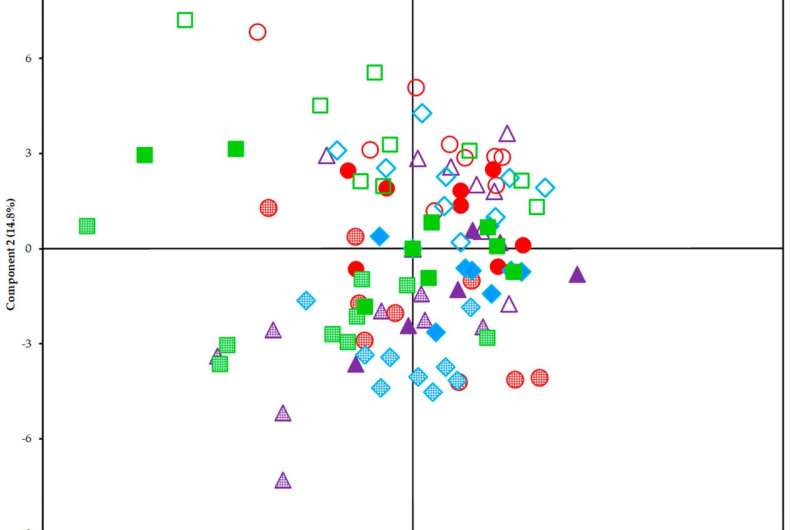This article has been reviewed according to Science X's editorial process and policies. Editors have highlighted the following attributes while ensuring the content's credibility:
fact-checked
trusted source
proofread
In resistance training, focusing on load or number of repetitions leads to same muscle growth

Which kind of resistance training promotes more muscle growth: low load with many repetitions or high load with fewer repetitions? According to a study conducted at the State University of Campinas (UNICAMP) in São Paulo state, Brazil, it makes no difference.
The study lasted eight weeks and involved 18 volunteers in two different training protocols. One group performed high-load (HL) exercises with fewer repetitions, while the other did low-load (LL) exercises with more repetitions. Muscle mass was measured in the first and last exercise sessions. A comparison of the two groups did not show any difference in muscle growth or metabolic stress, measured in an analysis of substances released into the bloodstream by the exercises.
In the HL group, each individual lifted up to 80% of their own weight. In the LL group, the limit was 30%, but they repeated the exercises until their muscles could no longer lift the loads.
The study was published in the journal Metabolites.
"Resistance training is known to promote muscle growth, but it's still not completely clear whether the key to muscle hypertrophy is the load or the number of repetitions. Our study supports the theory that both types have the same effect. We also showed that muscle activation occurs in a different manner in each type, although metabolic stress is the same and the effect on hypertrophy is therefore also the same," said Renato Barroso, a professor at UNICAMP's School of Physical Education.
In the assessments performed before and after the first and last training sessions, blood samples were collected before exercises began, five minutes after they ended and an hour after. The blood samples were submitted to metabolomic analysis, in which the metabolites in the bloodstream are detected. Muscle activation was measured by surface electromyography, in which electrodes monitor electrical activity in the muscles in real time.
"The metabolic stress response was expected to be stronger in the LL group because in theory this extra stress should offset the lower level of muscle activation, but that wasn't what we observed," Barroso said.
The analysis showed that although the level of muscle activation was higher in the HL group, metabolic stress was similar in both groups. "The similarity of the metabolic responses suggests that both types of training may act on the same pathways to induce hypertrophy," Barroso said.
Variations in metabolites
The metabolomic analysis detected variations in 50 metabolites in the blood in response to muscle activation during both types of training. However, few of these metabolites differed in the two groups. The researchers analyzed six of these few (asparagine, 3-hydroxyisovalerate, acetoacetate, carnitine, creatine and phosphocreatine).
Although the researchers found no differences in the overall metabolic response, they observed that some metabolites correlated with muscle hypertrophy in both groups. Some of these correlations, they concluded, may be associated with the characteristics of the muscle fibers activated by exercise (type 1 or type 2) as well as the metabolic demands of the training protocols used in the study.
"Some of the metabolites studied come from anaerobic energy systems and are produced by glycolysis [glucose breakdown] in the muscles or the breakdown of creatine and phosphocreatine, which supplies sufficient energy to maintain exercise intensity for a few seconds. Asparagine and acetoacetate are associated mainly with the Krebs cycle, which uses oxygen and nutrients such as fat, protein and carbohydrate to produce energy for the muscles and lasts a great deal longer," Barroso said.
Expression of creatine and phosphocreatine was expected to be higher in response to anaerobic exercise. "The metabolism involved there is characteristic of type 2 muscle fiber, which is known as 'fast twitch' fiber, whereas asparagine, for example, could be found when the cellular respiration stage known as the Krebs cycle is more activated. So it's characteristic of type 1 fiber," he explained.
In HL training, activation of type 2 muscle fiber predominates because of the higher load. "These muscle fibers have low oxidative activity but high glycolytic activity and may be more responsive to hypertrophy than type 1 fibers. On the other hand, LL training, which has more repetitions, more preferentially activates type 1 fibers, which have low glycolytic capacity and high oxidative capacity, and are highly fatigue-resistant," he said.
More information: Denis F. Valério et al, Serum Metabolites Associated with Muscle Hypertrophy after 8 Weeks of High- and Low-Load Resistance Training, Metabolites (2023). DOI: 10.3390/metabo13030335



















